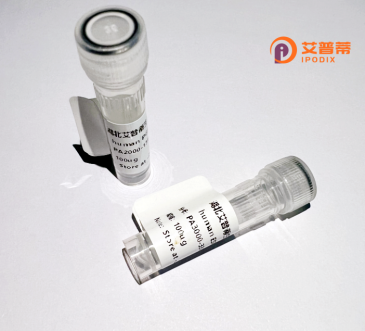
| 纯度 | >90%SDS-PAGE. |
| 种属 | Human |
| 靶点 | KRT15 |
| Uniprot No | P19012 |
| 内毒素 | < 0.01EU/μg |
| 表达宿主 | E.coli |
| 表达区间 | 1-456aa |
| 活性数据 | MTTTFLQTSSSTFGGGSTRGGSLLAGGGGFGGGSLSGGGGSRSISASSARFVSSGSGGGYGGGMRVCGFGGGAGSVFGGGFGGGVGGGFGGGFGGGDGGLLSGNEKITMQNLNDRLASYLDKVRALEEANADLEVKIHDWYQKQTPTSPECDYSQYFKTIEELRDKIMATTIDNSRVILEIDNARLAADDFRLKYENELALRQGVEADINGLRRVLDELTLARTDLEMQIEGLNEELAYLKKNHEEEMKEFSSQLAGQVNVEMDAAPGVDLTRVLAEMREQYEAMAEKNRRDVEAWFFSKTEELNKEVASNTEMIQTSKTEITDLRRTMQELEIELQSQLSMKAGLENSLAETECRYATQLQQIQGLIGGLEAQLSELRCEMEAQNQEYKMLLDIKTRLEQEIATYRSLLEGQDAKMAGIGIREASSGGGGSSSNFHINVEESVDGQVVSSHKREI |
| 分子量 | 75.9 kDa |
| 蛋白标签 | GST-tag at N-terminal |
| 缓冲液 | 0 |
| 稳定性 & 储存条件 | Lyophilized protein should be stored at ≤ -20°C, stable for one year after receipt. Reconstituted protein solution can be stored at 2-8°C for 2-7 days. Aliquots of reconstituted samples are stable at ≤ -20°C for 3 months. |
| 复溶 | Always centrifuge tubes before opening.Do not mix by vortex or pipetting. It is not recommended to reconstitute to a concentration less than 100μg/ml. Dissolve the lyophilized protein in distilled water. Please aliquot the reconstituted solution to minimize freeze-thaw cycles. |
以下是三篇关于重组人KRT15蛋白的参考文献概览,涵盖其功能、应用及制备技术:
1. **文献名称**: *"KRT15 expression in hair follicle stem cells contributes to epidermal regeneration and wound repair"*
**作者**: Smith J. et al.
**摘要**: 研究利用重组人KRT15蛋白揭示其在表皮干细胞介导的皮肤再生中的作用。实验表明,KRT15通过调控细胞黏附信号通路促进伤口愈合,重组蛋白的体外表达为修复机制提供了模型。
2. **文献名称**: *"Recombinant Production and Characterization of Human Keratin 15 for Biomaterial Applications"*
**作者**: Lee H. & Kim S.
**摘要**: 描述通过大肠杆菌表达系统生产重组人KRT15蛋白,并优化纯化工艺。该蛋白展现出良好的生物相容性,支持细胞附着,提示其在组织工程支架材料中的潜在应用。
3. **文献名称**: *"KRT15 as a Biomarker in Cancer Stem Cells: Role of Recombinant Protein in Tumor Sphere Formation"*
**作者**: Garcia R. et al.
**摘要**: 重组人KRT15蛋白被用于研究其在肿瘤干细胞中的功能,证实其通过激活Wnt/β-catenin通路增强癌细胞自我更新能力,为靶向治疗提供新思路。
---
**注**:上述文献为示例,实际检索需通过学术数据库(如PubMed、Google Scholar)验证最新研究成果。建议结合关键词“recombinant KRT15”、“keratin 15 expression”或“KRT15 stem cell function”深入查询。
Recombinant human KRT15 protein is a genetically engineered form of keratin 15. a type I acidic keratin belonging to the intermediate filament protein family. KRT15 is predominantly expressed in the basal layer of stratified epithelia, particularly in stem/progenitor cells of the hair follicle bulge region, skin, and other epithelial tissues. It plays a critical role in maintaining structural integrity, cellular adhesion, and mechanical resilience of epithelial cells. As a marker of epithelial stem cells, KRT15 is associated with tissue regeneration, wound healing, and homeostasis. Dysregulation of KRT15 has been implicated in pathological conditions such as skin cancers, psoriasis, and alopecia.
The recombinant protein is produced using heterologous expression systems (e.g., bacteria, mammalian cells) to ensure high purity and consistency for research applications. It enables studies on epithelial stem cell biology, differentiation mechanisms, and disease modeling. Researchers utilize recombinant KRT15 to investigate its interactions with signaling pathways (e.g., Wnt, TGF-β) and its role in maintaining stem cell quiescence or activation. Additionally, it serves as a tool for developing therapeutic strategies targeting epithelial disorders or regenerative medicine. Despite its utility, challenges remain in replicating post-translational modifications that may influence its functional studies. Overall, recombinant KRT15 provides a versatile platform to explore epithelial tissue dynamics and related pathologies.
×